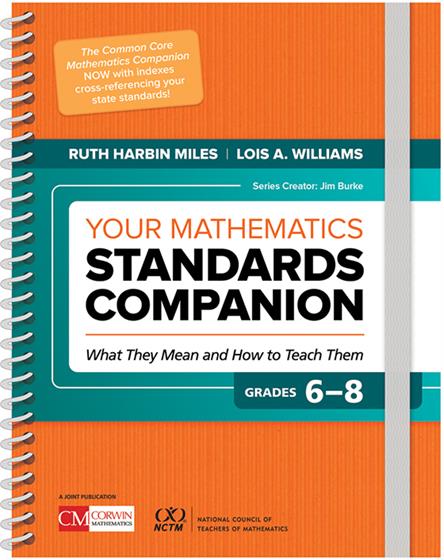Indexes Cross-Referencing Your State Standards
Quick Reference Guide
Acknowledgments
Letter to Grades 6–8 Teachers
Letter to Middle School Principals
Introduction
A Brief History of Current State Standards
College and Career Ready Standards for Mathematics
Instructional Shifts
Terminology Used in This Book
Effective Teaching Practices
How to Use This Book
Reflection Questions
Part 1. Ratios and Proportional Relationships
Domain Overview
Suggested Materials for This Domain
Key Vocabulary
Grade 6
Cluster A: Understand ratio concepts and use ratio reasoning to solve problems.
Sample Planning Page: Ratios and Proportional Relationships, Grade 6, Cluster A
Planning Page
Grade 7
Cluster A: Analyze proportional relationships and use them to solve real-world and mathematical problems.
Sample Planning Page: Ratios and Proportional Relationships, Grade 7, Cluster A
Planning Page
Reflection Questions: Ratios and Proportional Relationships
Part 2. The Number System
Domain Overview
Suggested Materials for This Domain
Key Vocabulary
Grade 6
Cluster A: Apply and extend previous understandings of multiplication and division to divide fractions by fractions.
Cluster B: Compute fluently with multi-digit numbers and find common factors and multiples.
Cluster C: Apply and extend previous understandings of numbers to the system of rational numbers.
Sample Planning Page: The Number System, Grade 6, Cluster C
Planning Pages
Grade 7
Cluster A: Apply and extend previous understandings of operations with fractions to add, subtract, multiply, and divide rational numbers.
Sample Planning Page: The Number System, Grade 7, Cluster A
Planning Page
Grade 8
Cluster A: Know that there are numbers that are not rational, and approximate them by rational numbers.
Sample Planning Page: The Number System, Grade 8, Cluster A
Planning Page
Reflection Questions: The Number System
Part 3. Expressions and Equations
Domain Overview
Suggested Materials for This Domain
Key Vocabulary
Grade 6
Cluster A: Apply and extend previous understandings of arithmetic to algebraic expressions.
Cluster B: Reason about and solve one-variable equations and inequalities.
Cluster C: Represent and analyze quantitative relationships between dependent and independent variables.
Sample Planning Page: Expressions and Equations, Grade 6, Cluster C
Planning Pages
Grade 7
Cluster A: Use properties of operations to generate equivalent expressions.
Cluster B: Solve real-life and mathematical problems using numerical and algebraic expressions and equations.
Sample Planning Page: Expressions and Equations, Grade 7, Cluster A
Planning Pages
Grade 8
Cluster A: Work with radicals and integer exponents.
Cluster B: Understand the connections between proportional relationships, lines, and linear equations.
Cluster C: Analyze and solve linear equations and pairs of simultaneous linear equations.
Sample Planning Page: Expressions and Equations, Grade 8, Cluster A
Planning Pages
Reflection Questions: Expressions and Equations
Part 4. Functions
Domain Overview
Suggested Materials for This Domain
Key Vocabulary
Grade 8
Cluster A: Define, evaluate, and compare functions.
Cluster B: Use functions to model relationships between quantities.
Sample Planning Page: Functions, Grade 8, Cluster A
Planning Pages
Reflection Questions: Functions
Part 5. Geometry
Domain Overview
Suggested Materials for This Domain
Key Vocabulary
Grade 6
Cluster A: Solve real-world and mathematical problems involving area, surface area, and volume.
Sample Planning Page: Geometry, Grade 6, Cluster A
Planning Page
Grade 7
Cluster A: Draw, construct, and describe geometrical figures and describe the relationships between them.
Cluster B: Solve real-life and mathematical problems involving angle measure, area, surface area, and volume.
Sample Planning Page: Geometry, Grade 7, Cluster B
Planning Pages
Grade 8
Cluster A: Understand congruence and similarity using physical models, transparencies, or geometry software.
Cluster B: Understand and apply the Pythagorean Theorem.
Cluster C: Solve real-world and mathematical problems involving volume of cylinders, cones, and spheres.
Sample Planning Page: Geometry, Grade 8, Cluster A
Planning Pages
Reflection Questions: Geometry
Part 6. Statistics and Probability
Domain Overview
Suggested Materials for This Domain
Key Vocabulary
Grade 6
Cluster A: Develop understanding of statistical variability.
Cluster B: Summarize and describe distributions.
Sample Planning Page: Statistics and Probability, Grade 6, Cluster B
Planning Pages
Grade 7
Cluster A: Use random sampling to draw inferences about a population.
Cluster B: Draw informal comparative inferences about two populations.
Cluster C: Investigate chance processes and develop, use, and evaluate probability models.
Sample Planning Page: Statistics and Probability, Grade 7, Cluster C
Planning Pages
Grade 8
Cluster A: Investigate patterns of association in bivariate data.
Sample Planning Page: Statistics and Probability, Grade 8, Cluster A
Planning Page
Reflection Questions: Statistics and Probability
Resources
Table 1. Standards for Mathematical Practice
Table 2. Effective Teaching Practices
Reproducibles
Reproducible 1. Percent Wheel
Reproducible 2. Frayer Model
Reproducible 3. Net of a Cube
Reproducible 4. Example for MAD (Mean Absolute Deviation)
Additional Resources
About the Authors



